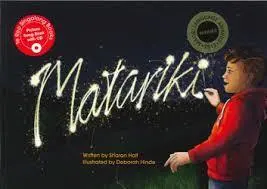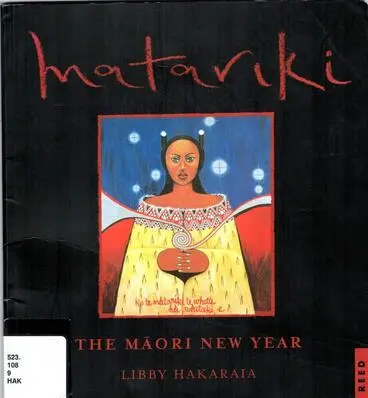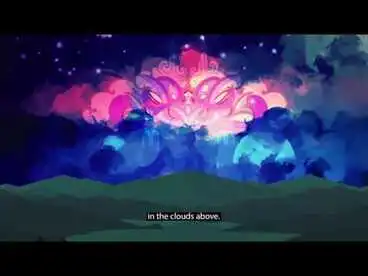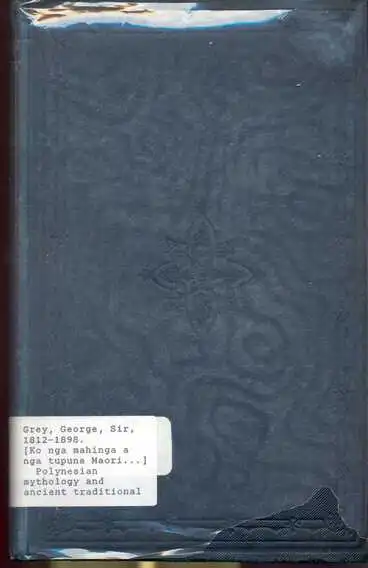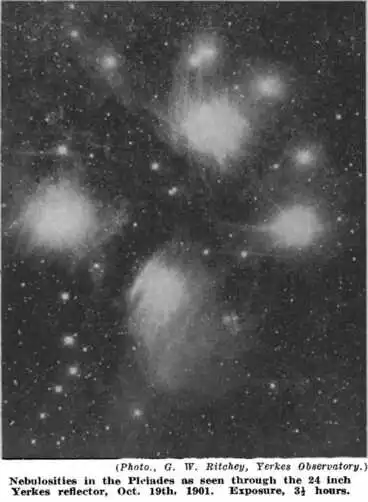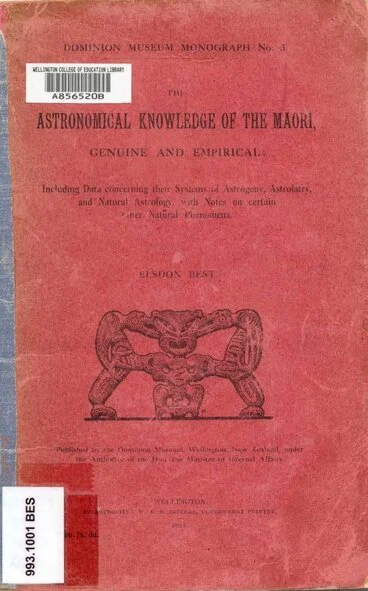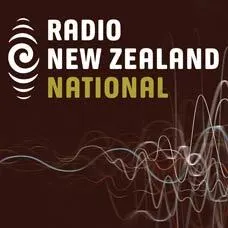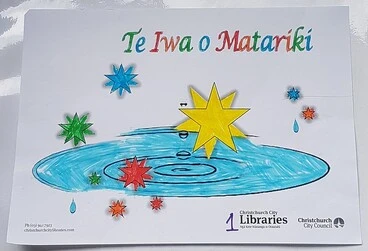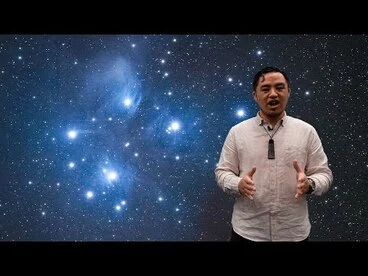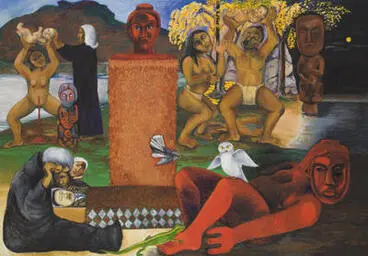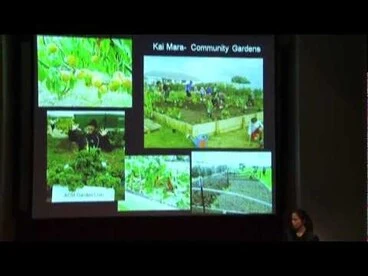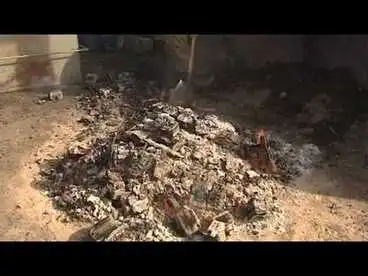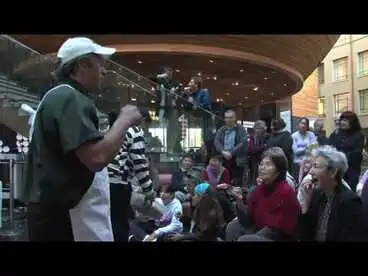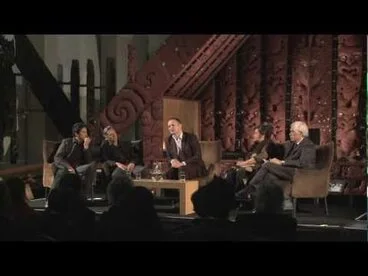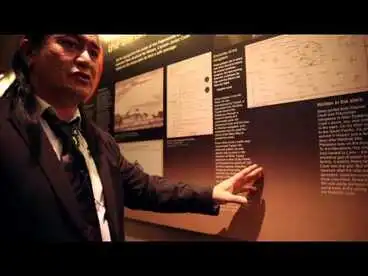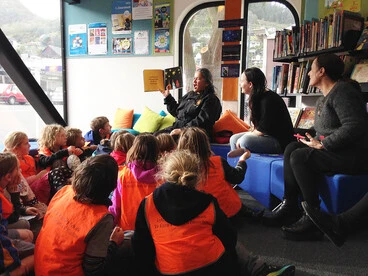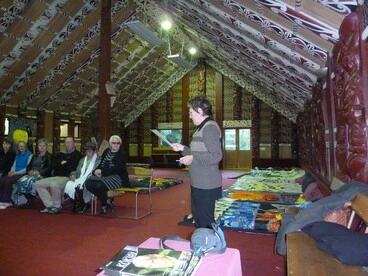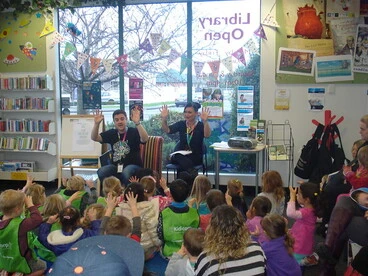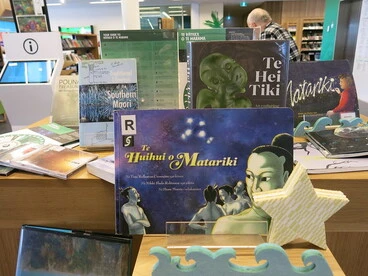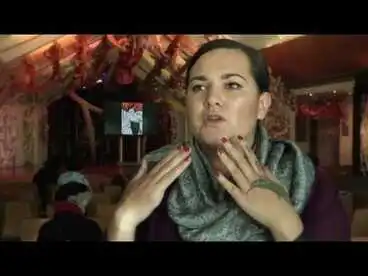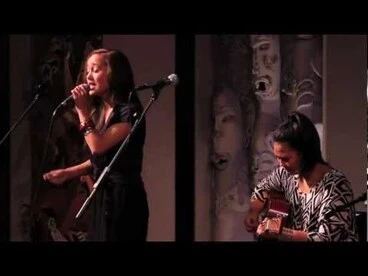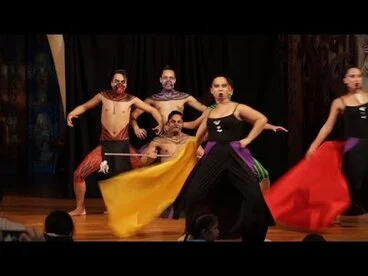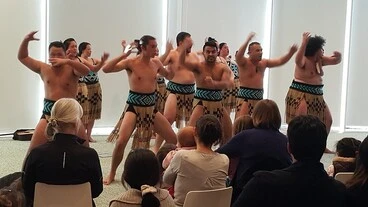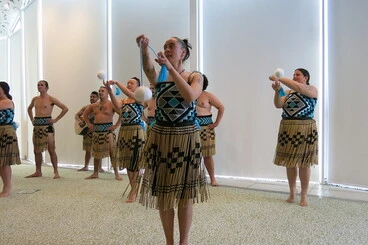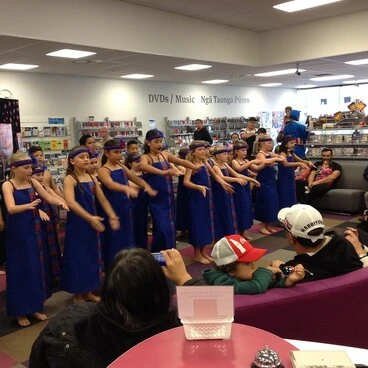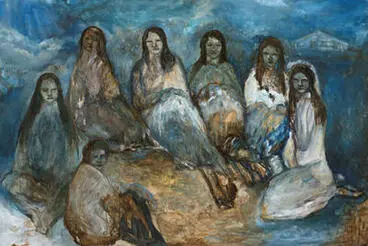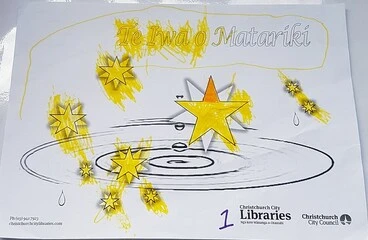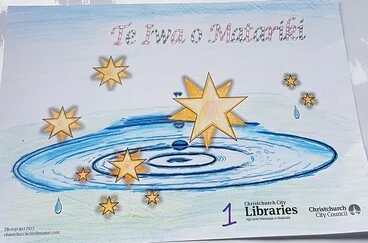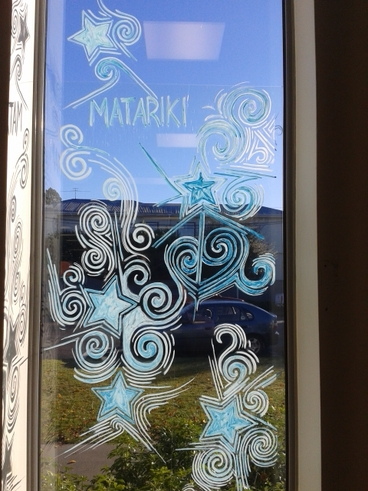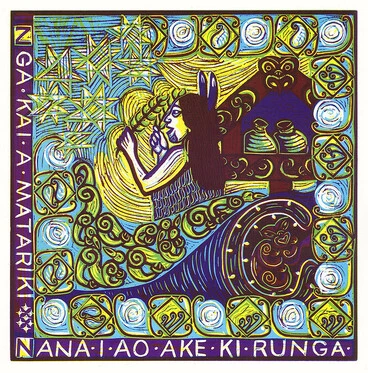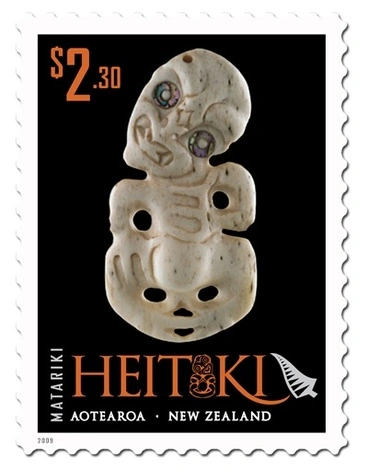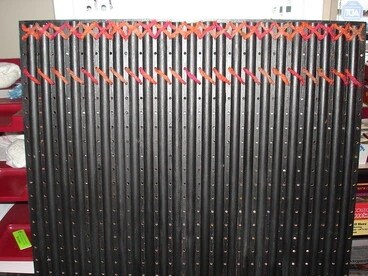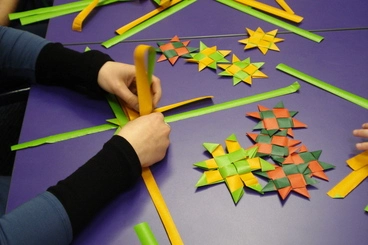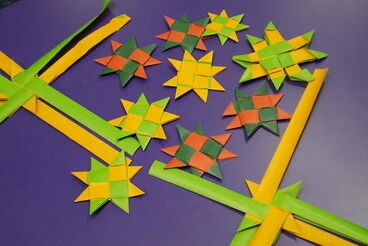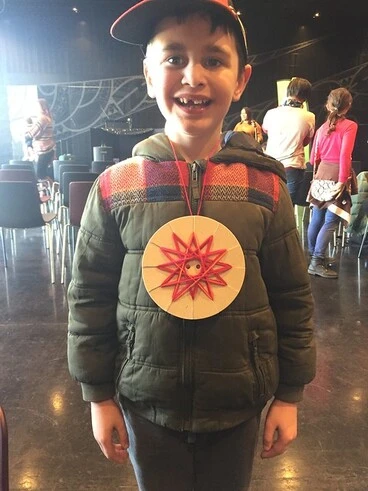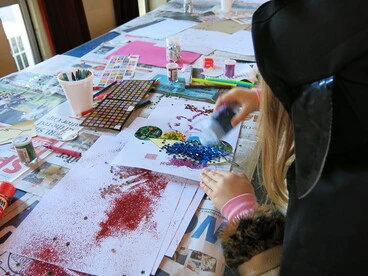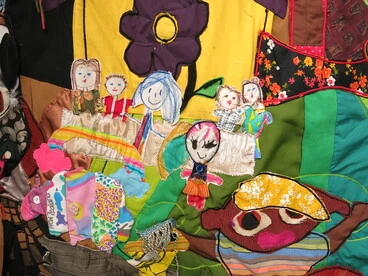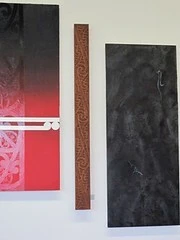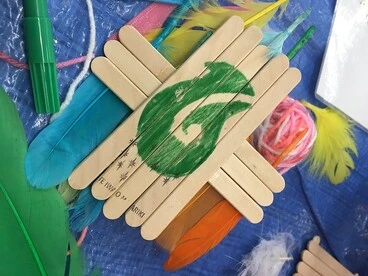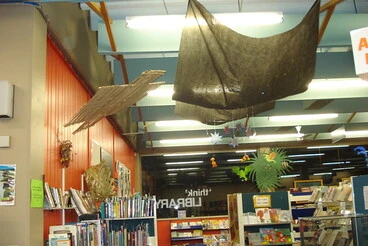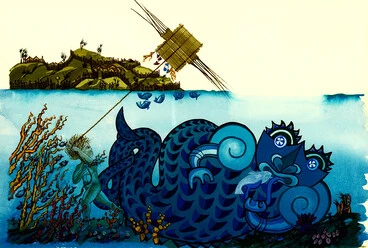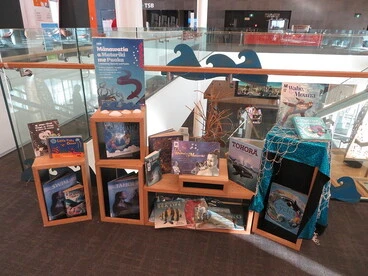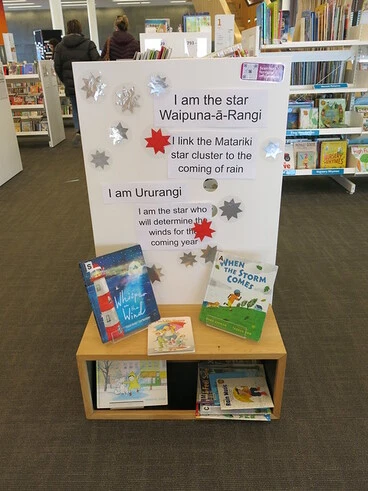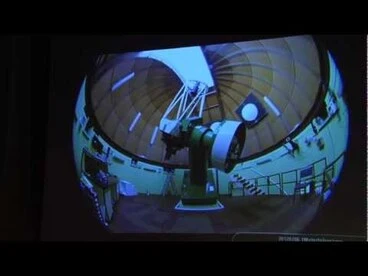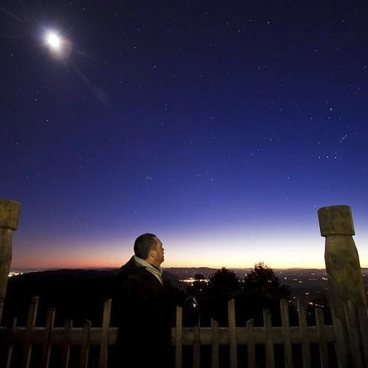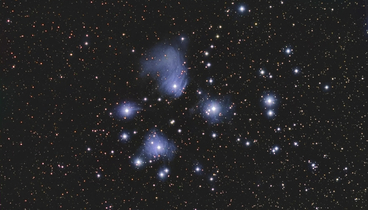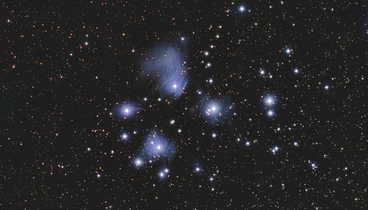Matariki - the Māori New Year
A DigitalNZ Story by Zokoroa
Matariki is the Māori name for the cluster of stars, also known as the Pleiades, that herald in the New Year around June-July. An overview of traditional knowledge and contemporary celebrations is given, together with suggestions for activities.
Matariki, Pleiades, stars, sky, New Year, moon, celebrations, festivals, holidays, Rangi, Papa, astronomy, Maori
Matariki - the Māori New year
Matariki is the Māori name for the cluster of stars that rises in midwinter in the constellation of Taurus. For many Māori, Matariki signals the start of Te Mātahi o te Tau, the Māori New Year. It is a time to remember those who've passed since the last rising of Matariki, to celebrate the present, and to look to the future.
Beginning in 2022, Matariki is marked by a public holiday set annually until 2052 by Te Pire mō te Hararei Tūmatanui o te Kāhui o Matariki/Te Kāhui o Matariki Public Holiday Bill, which passed its third reading on 6 April 2022 and became law. The holiday date falls on the Friday closest to the four days of the nights of Tangaroa - when the last quarter-moon rises - in the lunar month of Piripi, which usually falls from late June to mid-July. During 2025, Matariki will be observed on Friday, 20th June.
Matariki – Official website from Te Arawhiti - The Office for Crown Māori Relations provides the current year’s theme. It also lists events, information about Matariki and resources. Also check your local Council's website/Facebook pages for Matariki celebrations that you and your community can be part of each year.
Matariki
Auckland War Memorial Museum Tāmaki Paenga Hira
Matariki is the Māori name for the cluster of stars that rises in midwinter in the constellation of Taurus
Manatū Taonga, the Ministry for Culture and Heritage
Matariki, for many Māori, signals the start of Te Mātahi o te Tau, the Māori New Year
It is a time to celebrate life, remember those who've passed and to plan for the future
MOTAT
Beginning in 2022, Matariki is marked by a public holiday set annually until 2053
Holiday is on the Friday closest to Tangaroa lunar phase - when last quarter-moon rises - of Piripi (between June-July)
Manatū Taonga, the Ministry for Culture and Heritage
Matariki known by different names by other cultures:
The Matariki star cluster is known by different names by other cultures. Pleiades is the common name in Western culture and was derived from Greek mythology. The Pleiades were the seven daughters of the titan Atlas and the sea-nymph Pleione. Zeus immortalised the sisters by turning them into doves and then into stars to form the Pleiades in the Taurus constellation. The Hawaiian name is Makali‘i, or ‘eyes of royalty’, and in Japan it is Subaru, meaning ‘gathered together’. To find out more about other cultures, see Wikipedia's article: Pleiades in folklore and literature.
The star cluster is known by different names by other cultures
Pleiades (Greek, & English & other western countries), Makali‘i (Hawaiian) & Subaru (Japanese)
National Library of New Zealand
Traditional Māori knowledge and Matariki
According to traditional Māori knowledge, Ranginui (the sky father) and Papatūānuku (the earth mother) were separated from their eternal embrace by their children. The children (all sons) had lived cramped together in the darkness between their parents and wanted more freedom to be able to move around. One brother, Tūmatūenga (god of war and people), had suggested that they slay their parents. However, Tāne Mahuta (god of the forests) suggested that they separate their parents forever. All the brothers agreed, except for Tawhirimatea (god of weather).
Rangi (Sky) and Papa (Earth)
were separated by their children so that they would no longer live in darkness
Manatū Taonga, the Ministry for Culture and Heritage
Carving of Rangi, Papa and other gods by Cliff Whiting
(A mural at the National Library of New Zealand, Wellington)
Manatū Taonga, the Ministry for Culture and Heritage
Rangi and Papa's children
Clockwise from top: Tāne Mahuta, Tūmatauenga, Tangaroa, Haumia-tiketike, Rūaumoko, Rongomātāne, Tāwhirimātea
Manatū Taonga, the Ministry for Culture and Heritage
Separation of Rangi and Papa:
Tāne Mahuta was able to separate their parents by lying on his back and using his legs to push their father Rangi higher into the sky. Angry at his brothers, Tāwhirimātea joined Rangi in the skies and, together, they plotted revenge against them. (See Te Ara article on how the four winds, rain and hail were used.) During the stormy weather, Tūmatauenga stood firm and developed incantations for calm weather.
Tāne Mahuta, god of forests, raised Rangi
Manatū Taonga, the Ministry for Culture and Heritage
Tāwhirimātea, god of weather, fought his brothers
Manatū Taonga, the Ministry for Culture and Heritage
Tūmatauenga, god of war & people, calmed the storms
Manatū Taonga, the Ministry for Culture and Heritage
Matariki - the Eyes of the God:
In pain at the separation of his parents, Tāwhirimātea gouged out his eyes and threw the pieces into the Milky Way galaxy. Matariki has been thought to mean either the ‘eyes of god’ (mata ariki) or ‘little eyes’ (mata riki). However, according to Dr Rangi Mātāmua, there are no stories to support the meaning 'little eyes'. Rather, Matariki is an abbreviation of ‘Ngā Mata o te Ariki’ – 'The Eyes of the God' Tāwhirimātea.
Milky Way galaxy
Manatū Taonga, the Ministry for Culture and Heritage
Rangi and Papa - videos:
The story of Rangi and Papa has been retold in animated videos. See examples below. There is also a Youtube clip by Auckland Libraries: Matariki [Ngā mata o te ariki, o Tāwhirimātea: The eyes of the god, Tāwhirimātea]
A Matariki story
Radio New Zealand
How Matariki was formed
Manatū Taonga, the Ministry for Culture and Heritage
RANGI AND PAPA - DIGITISED STORIES:
The story of Rangi and Papa has also been retold in written stories. The following can be read online:
Stories on TKI: Māori myths, legends and contemporary stories - see story about Tāwhirimātea
International Children's Digital Library: Māori legends for young New Zealanders and Weaving earth and sky
New Zealand Electronic Text Collection (NZETC) has the following titles by Sir George Grey, Elsdon Best and James Cowan which can be read online.
Sir George Grey (1885)
(Read online at NZETC)
Victoria University of Wellington
Elsdon Best (1924)
(Read online at NZETC)
Victoria University of Wellington
James Cowan (1987)
(Read online at NZETC)
Victoria University of Wellington
Matariki and Māori astronomy
Traditional accounts and star lore have been captured in Elsdon Best's The astronomical knowledge of the Maori (1922) through interviews with iwi. One of the contributors was astronomer Te Kōkau Himiona Te Pikikōtukua who had begun compiling a 400-page manuscript with his son Rāwiri Te Kōkau in Ruatāhuna from 1898. It was completed by Rāwiri in 1933 and handed down from grandson to grandson, whereby Dr Rangi Mātāmua carried out further research and published the book Matariki, The Star of the Year in 2017. The knowledge of the elders during the nineteenth century from the East Coast of Te Ika-a-Maui (North Island) has also been researched and published in Work of the Gods: Tātai Arorangi - Māori astronomy by Kay Leather and Richard Hall (2004).
Elson Best (1922)
Victoria University of Wellington
Matariki - seven or nine stars?:
Most commonly known in Western culture as the Pleiades or “seven sisters” of Greek myth, this cluster of stars is said to number seven or more stars. One of the popular versions is that the star Matariki is the whaea (mother), surrounded by her six daughters, Tupu-ā-nuku, Tupu-ā-rangi, Waipuna-ā-rangi, Waitī and Waitā, and Ururangi. (See Te Papa website.)
Dr. Rangi Mātāmua, however, says there are nine stars in te kāhuia o Matariki (the cluster of Matariki) - Matariki, Tupu-ā-nuku, Tupu-ā-rangi, Waipuna-ā-rangi, Waitī, Waitā, Ururangi, Pōhutukawa, and Hiwa-i-te-rangi. (See Te Karere TVNZ interview) Viewing with the naked eye, between 7 and 14 stars of the over 1000 stars within this cluster have been seen.
The meaning of the 9 stars:
Te Papa: Matariki: The Māori New Year gives the following information:
Matariki is the star that signifies reflection, hope, our connection to the environment, and the gathering of people. Matariki is also connected to the health and wellbeing of people.
Waitī is associated with all fresh water bodies and the food sources that are sustained by those waters.
Waitā is associated with the ocean, and food sources within it.
Waipuna-ā-rangi is associated with the rain.
Tupuānuku is the star associated with everything that grows within the soil to be harvested or gathered for food.
Tupuārangi is associated with everything that grows up in the trees: fruits, berries, and birds.
Ururangi is the star associated with the winds.
Pōhutukawa is the star associated with those that have passed on.
Hiwa-i-te-rangi is the star associated with granting our wishes, and realising our aspirations for the coming year.
Also see Christchurch City Libraries - Matariki — the Aotearoa / Pacific New Year which has posters and information about each of the stars. Te Arawhiti has published a downloadable booklet Matariki Karakia (pdf, 2023) which contains karakia for each of the nine stars of Matariki.
MARAMATAKA - MĀORI LUNAR calendar
The Māori lunar calendar, called Maramataka ("the moon turning") has 354 days, whereas the Gregorian calendar used by New Zealand and other Western countries, has an average number of 365.2422 days (taking Leap Year into account), The Gregorian calendar is based on the number of 'solar' days the Earth takes to revolve around the sun. (See: Wikipedia: Gregorian calendar)
Each phase of the moon was named and each typical year was marked by the passage of 12 or 13 lunar months (depending on the iwi). The Māori calendar begins in Pipiri (June/July) with the reappearance of the Matariki star cluster signalling the New Year. A lunar month is the 29.53 days between new moons, and normally straddles two calendar months of the Gregorian calendar.
Tūtakangahau, a Ngāi Tūhoe chief from Maungapōhatu, provided the ethnographer Elsdon Best with these names and descriptions:
Pipiri (May–June): Ka pipiri ngā mea katoa i te whenua i te mātao, me te tangata. All things on earth are contracted because of the cold; likewise man.
Hongonui (June–July): Kua tino mātao te tangata, me te tahutahu ahi, ka pāinaina. Man is now extremely cold, and so kindles fires before which he basks.
Here-turi-kōkā (July–August): Kua kitea te kainga a te ahi i ngā turi o te tangata. The scorching effect of fire on the knees of man is seen.
Mahuru (August–September): Kua pūmahana te whenua, me ngā otaota, me ngā rākau. The earth has now acquired warmth, as also have herbage and trees.
Whiringa-ā-nuku (September–October): Kua tino māhana te whenua. The earth has now become quite warm.
Whiringa-ā-rangi (October–November): Kua raumati, kua kaha te rā. It has now become summer, and the sun has acquired strength.
Hakihea (November–December): Kua noho ngā manu kai roto i te kōhanga. Birds are now sitting in their nests.
Kohi-tātea (December–January): Kua makuru te kai: ka kai te tangata i ngā kai hou o te tau. Fruits are now ripe and man eats the new food of the season.
Hui-tanguru (January–February): Kua tau te waewae o Ruhi kai whenua. The foot of Ruhi (a summer star) now rests upon the earth.
Poutū-te-rangi (February–March): Kua hauhake te kai. The crops are now harvested.
Paenga-whāwhā (March–April): Kua putu ngā tupu o ngā kai i ngā paenga o ngā māra. All straw is now stacked at the borders of the plantations.
Haratua (April–May): Kua uru ngā kai kai te rua, kua mutu ngā mahi a te tangata. Crops are now stored in pits. The tasks of man are finished.
Source: Museum of New Zealand Te Papa Tongarewa: What is the Maramataka | the Māori lunar calendar?
Matariki and The New Year - Te Tau Hou
At the time of the Māori new year in Pipiri (May - June), Te Waka o Tamarereti (the great waka of Tamarereti) can be seen in the south. The waka is called Uruao. Tautoru (Orion's Belt) forms the stern, the tail of Scorpius is the prow, and Māhutonga (the Southern Cross) is the anchor and Te Taura o te Waka o Tamarēreti (the Pointers) are the anchor rope.
Te Waka o Tamarereti
Victoria University of Wellington
Locating Matariki:
To find the Matariki star cluster in the night sky, start with the Southern Cross and track east to three bright stars aligned in a row. This constellation is known as Orion's belt or Tautoru. See Youtube video How to find the Matariki star cluster with Martin Langdon from Te Papa's Learning Team.
How to find the Matariki star cluster
Museum of New Zealand Te Papa Tongarewa
Matariki infographic
Services to Schools
A beginner’s guide to finding Matariki
Services to Schools
Matariki or Puanga - the start of the New Year
Puanga is the first star to appear on the horizon, signalling that in three days Matariki would rise. For some iwi, Puanga (Puaka) – Rigel is the star that heralds the New Year as it always rises before Matariki (e.g. Taranaki and Whanganui iwi, and some on the West Coast of the South Island). However, for some iwi, Matariki marks the start of the New Year. For some Māori the first new moon after the rise of Matariki signals the start of the New Year celebrations. The moon (Marama) is seen as the start for all things new and guides the activities for the planting and harvesting of kai on the land and at sea.
Taranaki Māori celebrate Puanga - their version of Matariki, 2015
Taranaki Māori celebrate Puanga
Radio New Zealand
Māori New Year - when does it start?
The rising of Matariki takes place at pre-dawn during the last quarter of the moon cycle known as the Tangaroa nights of the moon. Unlike the Western world, this can vary from year to year but is always in the cold months from May to July. According to Dr. Rangi Mātāmua, Pleiades sets between May-June when the land sleeps, freezes over and lies idle. The setting of Matariki is known as Mātahi kari pīwai. Then around June to July, Matariki appears on the horizon at the pre-dawn of the day that signals the New Year. The Sun had travelled North and Matariki has gone to guide it back to the East to bring warmer weather. The rising of Matariki is known as Mātahi o te tau. The current year's dates can be viewed on the Ministry for Culture and Heritage's website.
Timing of Matariki - rises in last quarter of Tangaroa
Victoria University of Wellington
Matariki - spiritual connections
Matariki is a time for Māori to welcome the New Year and give thanks for the many blessings they had, while remembering those that had gone before them. It is usually associated with:
- remembrance - — honouring those who have died since the last rising of Matariki
- celebrating the present - gathering together with family and friends
- looking to the future — rebirth and regeneration as the seasons move towards warmer months of a new year.
Find out more:
- Values for Matariki Celebrations: Matariki Advisory Committee. Prepared by Professor Rangi Matamua on behalf of the Matariki Advisory Committee. Final Report V2 - 21 May 2021. (Outlines the three major principles and and the twelve key values of Matariki.)
- Matariki Te Whetū o te Tau: Videoed seminar with Dr Rangi Matamua and Living by the Stars & CORE Education, 29 June 2021 (Youtube:1:29:49)
How astronomy has influenced Māori beliefs and practices
Radio New Zealand
THE ANCIENT WISDOM OF THE MAORI. (Marlborough Express, 10 March 1900)
National Library of New Zealand
The Wisdom of the Maori The Call of the Stars - The New Zealand Railways Magazine, Volume 11, Issue 5 (August 1, 1936)
Victoria University of Wellington
Matariki - Time of remembrance:
When Matariki rises in the pre-dawn sky, it is a time for people to come together to honour those who have died since the last rising of Matariki and to acknowledge the year gone by. The ceremony usually took place on a high vantage point. A small hāngī would be prepared while waiting for Matariki to rise. The first sighting of Matariki was greeted with karakia and then the Tohunga Kōkōrangi would read the tohu. A fire would then be lit and those that had passed the previous year acknowledged with weeping and the reciting of the names of the departed.
Matariki: Cycles of life & death
Manatū Taonga, the Ministry for Culture and Heritage
As recounted in a Te Papa podcast with Dr. Rangi Mātāmua, the constellation Te Waka o Rangi is a canoe with Matariki at the front and Tautoru (Orion’s belt) at the back. It is captained by Taramainuku who casts his net Te Kupenga a Taramainuku down to earth to gather the souls of the people who died that day. He carries them along behind his waka for eleven months until May when the waka sets on the West Coast with the Sun. He then takes them to the underworld where they remain for a month. When Matariki rises again a month later, Taramainuku releases the souls of the dead into the sky to become stars. At the conclusion of the ceremony, the hāngī would be opened allowing the steam to rise up and give sustenance to those who had become stars. As well as a time of remembrance, Matariki is also a time to start letting go of grief and begin anew.
MATARIKI - TIME TO CELEBRATE THE PRESENT:
Matariki is also a time to celebrate the present by the gathering of family and friends.
Matariki celebrations
Manatū Taonga, the Ministry for Culture and Heritage
Matariki - Time to look to the future (rebirth and regeneration):
Matariki is also a time for looking ahead to the coming year. Tohunga would observe the stars and take meaning from each star's position, movement, colour and brightness to foretell the future. Puanga foretells the fortunes of the coming of the New Year by his appearance and placement when he first rises after the first new moon. Matariki confirms this through her placement and appearance when she appears three days later.
Tohunga looked to Matariki to predict if the next harvest would be abundant. If a star is brighter and clearer that the others stars, the warmer the growing season would be, ensuring a good crop would be harvested from that source. If a star is hazy or missing, there will be negative outcomes for the coming year as represented by that star.
To read the stars for what the year ahead will bring, Matariki must be read when the moon is in Tangaroa at the end of its third quarter and into the last quarter.
Harvesting fish:
Fishing by calendar could be cheaper
Radio New Zealand
Fishing - (Te Ao Hou - No. 40 September 1962)
Alexander Turnbull Library
Planting by the moon:
Planting and fishing
Manatū Taonga, the Ministry for Culture and Heritage
- (Te Ao Hou - No. 60 September 1967)
Alexander Turnbull Library
Council using Maori calendar as guide
Radio New Zealand
Growing native plants, potato and kumara:
Planting the Crop - Maori Agriculture
Victoria University of Wellington
Matariki: Native Plants with horticulturalist Char Wiapo
Auckland War Memorial Museum Tāmaki Paenga Hira
Growing potato & kumara
Services to Schools
How to grow your own kumara shoots
Services to Schools
A gardener’s guide to Matariki
Services to Schools
Carved pataka (storehouse) named Te Oha, Auckland Museum
Alexander Turnbull Library
Celebrating traditional kai during Matariki festivities:
Matariki traditions and contemporary culture
Matariki celebrations were popular for Māori in pre-European times. The festivals continued into the 1900s but were reported to have waned during the 1940s. (See articles below on 'Matariki - Māori New Year: Modern Matariki" by the Ministry for Culture and History, and "Matariki' published in Te Ao Ho.) However, the beginning of this century has seen a revival in celebrations. The traditions of Matariki and their place in contemporary culture have been explored in various forums - What does it mean to people in today's society?
Article by Te Ara on dwindling popularity of Matariki celebrations by the 1900s & resurgence since early 21st Century
Modern Matariki
Manatū Taonga, the Ministry for Culture and Heritage
Article by Harry Dansey on examples of customs that were observed, 1967
Matariki - (Te Ao Hou - No. 61 December 1967)
Alexander Turnbull Library
Research paper on Matariki by Ann Hardy, 2011
Re-designing the national imaginary: The development of Matariki as a contemporary festival
University of Waikato
Experts in Māori astronomy say the annual event has no connection to its traditional meaning, 2010
Matariki has no connection to its traditional meaning
Radio New Zealand
Panel discussion: Matariki and contemporary culture
Auckland War Memorial Museum Tāmaki Paenga Hira
Range of Matariki activities include Beyonce-poi, opera and kapa haka fused with crumping
A modern take on Matariki celebrations
Radio New Zealand
Cross-cultural involvement
Cross-cultural involvement has also increasingly taken place.
Cross-cultural involvement
Manatū Taonga, the Ministry for Culture and Heritage
Matariki ball in Sydney unites Māori and Pākehā
Radio New Zealand
Inspired Pacific weavers celebrate Matariki
Radio New Zealand
Tongan artist carves stars for Matariki
Radio New Zealand
journey to Matariki becoming a Public holiday in 2022
Over the years, there have been suggestions that Matariki should be marked by a public holiday.
Matariki Holiday Bill unsuccessful, 2009:
A Bill introduced to Parliament in 2009 failed to get political support.
Bill before Parliament in 2009 failed to get political support for a public holiday
Radio New Zealand
Ongoing public opinion:
Opinion
Opinion expressed in The Spinoff, June 2018
Radio New Zealand
Labour's Māori Party caucus
A proposal to make Mātariki a national holiday was being weighed up by the Labour Party's Māori caucus, 2018
Radio New Zealand
Petition launched 2020:
After Prime Minister Jacinda Ardern had said the government was considering more public holidays to help encourage domestic tourism, a petition in favour of Matariki was launched in 2020.
Government considering more public holidays, 2020
Prime Minister doesn't rule out having more public holidays, leading to Matariki being suggested
Radio New Zealand
Petition
Petition organiser Laura O'Connell-Rapira gathered over 2500 signatures for Matariki holiday by May 2020
Radio New Zealand
Survey
ActionStation survey of 1,128 people found 63% supportive
The Spinoff
Matariki public holiday announcement for 2022:
On 7 September 2020, Prime Minister Jacinda Arden pledged to make Matariki a public holiday if the Labour Party were re-elected in the 2020 general election. Following re-election, Ardern announced on 4 February 2021 that Matariki would begin to be celebrated as a public holiday on Friday 24 June 2022. The timing of the holiday to change from year to year and fall on a Monday or Friday. The Matariki Advisory Group was established to provide advice on future dates of the public holiday in consultation with iwi. On 2 July 2021, the day the constellation rose, Ardern announced the proposed dates for the next 30 years, beginning with the previously announced observance on Friday 24 June 2022.
If Labour re-elected in 2020, PM promises Matariki to be a public holiday
Radio New Zealand
Matariki Advisory Group established
Advisory Group establish to propose dates for the next 30 years in consultation with iwi
Radio New Zealand
Announcement (Feb 2021): First Matariki public holiday to be on Fri 24 June 2022
The observance date was announced by Prime Minister Ardern on 4 Feb 2021
Radio New Zealand
Te Kāhui o Matariki Public Holiday Bill became law, 7 April 2022
The Te Pire mō te Hararei Tūmatanui o te Kāhui o Matariki/Te Kāhui o Matariki Public Holiday Bill was introduced to Parliament on 27 September 2021 by Associate Minister for Arts, Culture and Heritage Kiri Allan. It passed its first reading on 30 September 2021 and second reading on 29 March 2022.
The Bill passed its third reading on 7 April 2022 and became law. It was supported by the Labour, Green, and Māori parties but was opposed by the National and ACT parties. National MP Pual Goldsmith argued that Matariki should replace one of the other 11 public holidays to reduce associated costs. ACT's Small Business spokesperson Chris Baillie claimed that having a new public holiday would cost businesses and quoted MBIE estimate of $450 million. Kiri Allen counter-argued that research shows that public holidays reduced employee stress and burnout while boosting hospitality and tourism.
Sources:
Te Pire mō te Hararei Tūmatanui o te Kāhui o Matariki/Te Kāhui o Matariki Public Holiday Bill (which also lists the dates of the Bill's readings in Parliament)
RNZ: "Matariki public holiday passes into law" (7 April 2022)
Te Kāhui o Matariki Public Holiday Bill made law (7 April 2022)
The bill passed its 1st reading on 29 Sept 2021 and its 3rd reading on 7 April 2022 and was made law
Radio New Zealand
Matariki celebrations
Festivals and exhibitions have been held to increase knowledge about the traditional astronomy and spiritual connections that underpins the Māori New Year. The Waikato Museum's Te Whānau Marama: The Heavenly Bodies Exhibition (2016 - 2018) featured a sound and light show. Other museums, public libraries, organisations, schools/kura and local communities have also held a range of activities. Artistic works, music, drama, stories and film have been created in celebration of Matariki.
Toa Waaka takes us through the Carter's Observatory in Wellington to discuss Matariki & Māori myths and legends
Matariki: Behind the celebration
Radio New Zealand
Waikato Museum's sound and light Matariki exhibition (2016 - 2018)
Exhibition shines light on Māori star lore
Radio New Zealand
The following types of activities are held to celebrate Matariki. For further ideas and creative inspiration, see the array of images available on DigitalNZ which are added to each year.
Storytelling Festivals:
Matariki stories
Christchurch City Libraries
Story blanket display at Rehua
Christchurch City Libraries
Matariki storytime at Te Kete Wānanga o Ōraka
Christchurch City Libraries
Matariki display at Tūranga
Christchurch City Libraries
Matariki 2016: Kōrero | Storytelling
Museum of New Zealand Te Papa Tongarewa
Poetry:
Te Kahu Rolleston - Matariki PoetrySlam
Radio New Zealand
Matariki poem written by Moana, age 12
Services to Schools
One of the poems submitted to Christchurch City Libraries during Matariki, 2020. Others can be accessed on DigitalNZ.
Ode to Matariki
Christchurch City Libraries
Music:
Manarangi Mua performing at Rangatahi Represent, during Matariki 2012 celebrations at Te Papa
Matariki 2012 Rangatahi Represent: Manarangi Mua
Museum of New Zealand Te Papa Tongarewa
Modern Maori Quartet talk about their song Māreikura created to celebrate Matariki
Modern Maori Quartet talk about their song Māreikura
Radio New Zealand
Music reviewer Kirsten Johnstone shares Matariki tunes, including from Whirimako Black & Dunedin rangatahi He Waka Kotu
Music for Matariki
Radio New Zealand
NZ Symphony Orchestra performs 'The glittering hosts of heaven' composed by Eve de Castro-Robinson
The glittering hosts of heaven
Manatū Taonga, the Ministry for Culture and Heritage
Matariki for string quartet by Natalie Hunt
Natalie Hunt: Matariki - downloadable PDF SCORE and PARTS
SOUNZ
Music video for Matariki performed by Hinewehi Mohi. includes an animation of the constellation & performance by a wero
Hinewehi Mohi. Matariki
Ngā Taonga Sound & Vision
Performing arts:
Matariki Festival 2016: Te Whare Mātoro – Performing Arts Weekend for Rangatahi
Museum of New Zealand Te Papa Tongarewa
Whirimako Black - LATE at the Museum
Auckland War Memorial Museum Tāmaki Paenga Hira
Te Pao a Tahu kapa haka group in performance
Christchurch City Libraries
Te Pao a Tahu kapa haka group in performance
Christchurch City Libraries
Hoon Hay School Kapa Haka performance
Christchurch City Libraries
RANGI & PAPA. AOTEA CENTRE
Ngā Taonga Sound & Vision
Modern telling of Matariki
Radio New Zealand
Film:
MATARIKI [TRAILER]
Ngā Taonga Sound & Vision
KETE ARONUI. SERIES 3. MATARIKI
Ngā Taonga Sound & Vision
Mai Time - Series 12, Episode 18
NZ On Screen
Paintings, Images, sculpture, carvings:
Matariki Y1-5 1st place winner Gariel
Christchurch City Libraries
Matariki Y10-12 Summer - 1st place winner
Christchurch City Libraries
Matariki window art, Fendalton Library
Christchurch City Libraries
Image for June from Ngā Marama o te Tau, a Māori calendar published by Te Puna Publications. 1990
'Nga Marama o te Tau', Hune 1990
Archives New Zealand Te Rua Mahara o te Kāwanatanga
New Zealand Post's $2.30 stamp from their 2009 Matariki issue
Hei Tiki Matariki stamp
Manatū Taonga, the Ministry for Culture and Heritage
Sculpture by Brett Graham explores the themes of creation, growth and knowledge (1994)
‘Te Matariki’
Manatū Taonga, the Ministry for Culture and Heritage
Contemporary carving
Manatū Taonga, the Ministry for Culture and Heritage
Kingitanga coat of arms: Door of Māhinārangi meeting house at Tūrangawaewae marae, Ngāruawāhia
Te Paki-o-Matariki
Manatū Taonga, the Ministry for Culture and Heritage
Weaving arts:
Tukutuku Panel named 'Matariki'
Museum of New Zealand Te Papa Tongarewa
Tukutuku panel 3
Christchurch City Libraries
Matariki yarn stars
Christchurch City Libraries
Matariki star weaving
Christchurch City Libraries
Otago Museum's webpage Weaving stars - Whetū has suggestions for reusing recycled materials to create stars - harakeke, ribbon, strips of fabric, craft paper, pages from old magazines and plastic strips that come around boxes.
Matariki star weaving at Hornby
Christchurch City Libraries
Matariki woven star, Tūranga
Christchurch City Libraries
Craftwork:
Matariki crafts
Christchurch City Libraries
Aroha Revolution: A community Matariki quilt
Christchurch City Libraries
Matariki Art
Christchurch City Libraries
Matariki toi - Manu tukutuku
Christchurch City Libraries
Kites:
Matariki at Bishopdale
Christchurch City Libraries
Celebrating Matariki at Archives New Zealand
Archives New Zealand Te Rua Mahara o te Kāwanatanga
Kite-making materials
Manatū Taonga, the Ministry for Culture and Heritage
Kites and Kite Flying - Games and Pastimes of the Maori
Victoria University of Wellington
Library displays:
Matariki display, Upper Riccarton Library, 30 May 2023
Matariki display, Upper Riccarton Library
Christchurch City Libraries
Matariki display at Tūranga, Christchurch, 31 May 2023
Matariki display, Tūranga
Christchurch City Libraries
Fireworks are ill-advised:
Some Councils have held fireworks displays. However, a Matariki Advisory Committee has stated that fireworks are ill-advised due to Mana Taiao-environmental awareness - fireworks pollute the dark sky with light and noise, and often pollute the ocean with debris. (See: Values for Matariki Celebrations: Matariki Advisory Committee. Prepared by Professor Rangi Matamua on behalf of the Matariki Advisory Committee. Final Report V2 - 21 May 2021)
A Matariki Advisory Group has stated fireworks are ill-advised for the environment (May 2021)
Matariki Fireworks
Wellington City Council Archives
Preserving and revitalising Māori astronomy
Initiatives include the Society of Māori Astronomy Research and Traditions (SMART), which was formed in 2009 to collect, preserve and revitalise Māori astronomical knowledge that might otherwise be lost. Marsden funding has also enabled research to be carried out for the three-year 'Te Mauria Whiritoi: The sky' study at the University of Waikato.
Waikato University study 'Te Mauria Whiritoi: The Sky'
Māori astronomer Rangi Matamua on Matariki
Radio New Zealand
Matariki exhibition show how Maori astronomy still relevant
Radio New Zealand
Maori astronomy under the telescope
Radio New Zealand
Astrophotography
Auckland War Memorial Museum Tāmaki Paenga Hira
Research paper: The science and practice of Māori astronomy and Matariki, 2020
The science and practice of Māori astronomy and Matariki
University of Waikato
Professor Rangi Matamua Kiwibank New Zealander of the Year 2022
Professor Rangi Matamua Kiwibank New Zealander of the Year
Radio New Zealand
Matariki and school curriculum activities
There is a range of activities that can be explored with students and their families.
Resource suggestions include:
CORE Education: Podcasts on Matariki
Kauwhata Reo lists curriculum resources which include activity cards, books (including eBooks), journals, apps, waiata, rotarota, videos, posters, teaching and learning programmes, and Maramataka.
National Archives (US) also has useful worksheets that can be adapted for helping students to analyse and make sense of photographs, posters, cartoons, maps, video, sound recordings, artifacts/objects and written documents
Science Learning Hub - Matariki and the Environment Aotearoa 2022 provides activity sheets to identify and label each of the nine stars in Matariki
Also see the following suggestions accessible on DigitalNZ:
National Library of New Zealand Topics: Matariki
Lists digital resources compiled by National Library of New Zealand Services to Schools
DigitalNZ
Many Answers: Matariki Y1-4
Websites and books compiled by National Library of New Zealand as part of its AnyQuestions service to schools
National Library of New Zealand
Many Answers: Matariki Y5-8
Websites and books compiled by National Library of New Zealand as part of its AnyQuestions service to schools
National Library of New Zealand
TKI: Matariki
Includes classroom activities that also involve iwi/hapū and community
Services to Schools
TKI: NZMaths - Level 3
Learning of mathematics around celebrations of Matariki
Services to Schools
TKI: NZMaths - Level 4
Learning of mathematics around celebrations of Matariki
Services to Schools
TKI: Literacy Online: Matariki
Report by Waitangi Teepa about stories and beliefs, and ways Matariki is celebrated
Services to Schools
TKI: Literacy Online
Fernridge School students have created a digital light display for Matariki using Raspberry Pi computers
Services to Schools
Christchurch City Libraries
Lists of links to online resources and websites
Services to Schools
Reading stories aloud
Video of 'The Little Kiwi’s Matariki' written by Nikki Slade-Robinson being read aloud
Services to Schools
Further matariki resources by other organisations:
Kiwi families
Ideas for families and communities to celebrate Matariki
Services to Schools
Matariki 2013 (Youtube)
An introduction to Matariki with activity suggestions for students
Services to Schools
Te Wānanga o Aotearoa
National Library of New Zealand
Matariki Classroom Resources
List of classroom resources on Pinterest
Services to Schools
This DigitalNZ story was updated in May 2025
